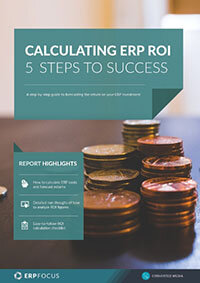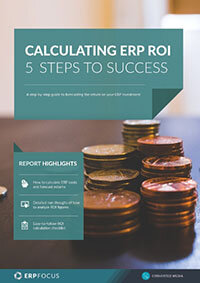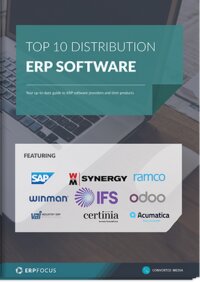Distribution ERP Software: Calculating ROI
Financial return on investment (ROI) for a distribution ERP solution is - at first glance - calculated the same way any other ERP ROI is calculated: divide the expected cost savings (and/or margin increases) by the expected costs, including implementation, software purchase, annual maintenance, hardware, etc. The key to making your ROI attractive is on the savings side of the calculation; there will not be enormous variation in the cost of implementation between similar sized distribution operations.
As a distributor who has gone through the ERP selection process, you may be asking yourself “how does a distribution operation make money with ERP?”. That depends on two things: (1) What level of software sophistication is ERP replacing, and (2) what process changes are envisioned as a result of implementing ERP?
If you have been running your distribution operation on pieces of paper, or computer spreadsheets, then distribution ERP represents an exponential increase in sophistication. In this case, you might look for opportunities to save money from elimination of administrative labor – automated billings, streamlined purchasing, or easier financial accounting, for instance. You should also look for savings from error reductions due to math or organization failures, either in billing rates, or missed billings. Yet another opportunity might be in modernizing with some of the standard functionality normally included on distribution ERP software, such as warehouse pick-and-pack strategies, or use of bar codes and scanners to aid in inventory storage and retrieval reporting. On the other hand, if your operation has utilized a reasonably sophisticated software solution in the past, either with home grown legacy applications, or collections of stand-alone third party solutions, then you may actually find labor swinging over to the “cost” side, as few distribution ERP modules are as efficient – in general - as programs written specifically to address distribution problems.
Process Change Enables Cost Savings
Process change is the biggest opportunity to achieve cost savings. A distribution ERP system itself rarely provides such robust transactional superiority that massive savings are recognized simply by using the software; rather, distribution ERP enables process change which enables cost savings. In the distribution arena, the largest opportunity to save cost through process change is in inventory carrying cost, inventory investment, and inventory obsolescence reduction. The process changes that might help accomplish those savings might occur as a result of real time data processing, better or more flexible replenishment planning, better analytics around slow-moving or inactive inventory, or improved inventory accuracy. A look at the expense side of the income statement will highlight other process changes that might make an impact: reductions in late fees and premium freight because of on-time delivery improvement; better accountability and analysis of returned goods; perhaps better scheduling of man-hours based on visibility of future customer order position.
At the end of the day, achieving distribution savings and a strong ERP ROI are usually about executing better, smarter, and faster. It is unusual for a distribution operation to have overlooked something fundamental to it’s success, and to discover that as a result of an ERP implementation. More common is that the distribution ERP implementation allows the distributor to think about doing things better.
There’s probably an ERP ROI there. You have to look for it.
Free white paper

Calculating ERP ROI: 5 steps to success
Calculate your new ERP's financial benefits with this comprehensive guide

Featured white papers
-

ERP Software Pricing Guide
Get the latest pricing information on over 80 popular ERP systems, and learn how to budget for your ERP project in our free guide
Download -

Calculating ERP ROI: 5 steps to success
Calculate your new ERP's financial benefits with this comprehensive guide
Download -

Top 10 Distribution Software Comparison
Compare the best distribution ERP systems available today
Download
Related articles
-

ERP for Food Distributors: Key Functionality
In a modern world where products are tailored to consumers, why should ERP for food distributors ...
-

Secret KPI: Why Your ERP Implementation Team Matters More Than Software
Learn how Godlan ensures successful ERP implementation for manufacturers with proven strategies &...
-
![Three direct links between ERP and manufacturing revenue [image by Snowing on Freepik] Three direct links between ERP and manufacturing revenue [image by Snowing on Freepik]](/pictures/W1siZiIsIjIwMjUvMDEvMjAva2ZwYjAzb3gzX1RocmVlX2RpcmVjdF9saW5rc19iZXR3ZWVuX0VSUF9hbmRfbWFudWZhY3R1cmluZ19yZXZlbnVlX2ltYWdlX2J5X1Nub3dpbmdfb25fRnJlZXBpa18uanBnIl0sWyJwIiwidGh1bWIiLCI0MDB4MjY2IyJdLFsicCIsImVuY29kZSIsImpwZyIsIi1xdWFsaXR5IDg1Il1d/Three%20direct%20links%20between%20ERP%20and%20manufacturing%20revenue%20%5Bimage%20by%20Snowing%20on%20Freepik%5D.jpg?sha=b45b02a140cc8680)
Three direct links between ERP and manufacturing revenue
What you need to know to help you achieve a return on your manufacturing ERP investment

